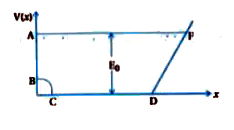A proton is kept at rest . A positively charged particle is released from rest at a distance d in its field .Consider two experiments , one in which the charged particle is also a proton and in another , a position . In same time t , the work done on the two moving charged particle is Solution in Gujrati
same as the same force law is involved in the two experiments
less for the case of a positron , as the positron moves away more rapidly and the force on it weakness
more for the case of a positron , as the positron moves away a larger distance
same as the work done by charged particle on the stationary proton .
The correct Answer is:C
Fproton=Fpositron
dproton<dpositron (∴mprotonmpositron)
∴Wproton<Wpositron(∴W=Fd)
Topper's Solved these Questions
- WORK, ENERGY AND POWER BOOK - KUMAR PRAKASHANCHAPTER - WORK, ENERGY AND POWER EXERCISE - SECTION - D NCERT Exemplar Solutions (Very Short Answer Type Questions)
12 Videos
- WORK, ENERGY AND POWER BOOK - KUMAR PRAKASHANCHAPTER - WORK, ENERGY AND POWER EXERCISE - SECTION - D NCERT Exemplar Solutions (Short Answer Type Questions)
10 Videos
- WORK, ENERGY AND POWER BOOK - KUMAR PRAKASHANCHAPTER - WORK, ENERGY AND POWER EXERCISE - SECTION - C Objective Questions (VSQs)
52 Videos
- WAVESBOOK - KUMAR PRAKASHANCHAPTER - WAVESEXERCISE - SECTION-F (Questions From Module) (Sample questions for preparation of competitive exams)
23 Videos
Similar Questions
A through inclined is placed on car moving with a constant velocity u on horizontal ground . A block of mass M rests on the inclined plane . Is any work done by force of friction then a dissipation of energy ?
View SolutionA graph of potential energy V(x) verses x is shown in figure .A particle of energy E0 is executing motion in it . Draw graph of velocity and kinetic energy verses x for one complete cycle AFA.

View SolutionIf →A=2ˆi−2ˆjand→B=2ˆk then →A.→B……
View SolutionIn a standing wave formed by two atoms separated by 1.21Å, there are 3 nodes and 2 antinodes. Find its wavelength.
View SolutionA proton is kept at rest. A positively charged particle is released from rest at a distance d in its field. Consider two experiments, one ini which the charged particle is also a proton and in another, a position. In the same time t , the work done on the two moving charged particles is
View SolutionAssertion : A charge particle is released particle is released from rest in magnetic field then it will move in circular path.
Reason : Work done by magnetic field is non zero.
View SolutionA positively charged particle is released from rest in a uniform electric field. The electric potential energy of the charge
View Solutionएक प्रोट्रॉन विरामावस्था में है। इसके क्षेत्र में d दूरी पर विराम से एक धनावेशित कण को छोड़ा जाता है। दो प्रयोगों पर विचार कीजिए, एक तो वह जिसमें आवेशित कण प्रोट्रॉन है तथा अन्य में पॉजीट्रॉन है। समान समय t में, दो गतिमान आवेशित कणों पर किया गया कार्य होता है
View SolutionA positively charged particle is released from rest in an uniform electric field. The electric potential energy of the charge
View SolutionA positively charged particle is released from rest in an unform electric field. The electric potential energy of the charge
View SolutionA proton is placed at rest. Another positively charged particle in its area is released at a d-stop period only. Consider two experiments, the first one in which the second charged particle is also a proton and the second one in which the second positively charged particle is a positron. Work done on both moving particles at the same time t
View SolutionA proton is kept at rest. A positively charged particle is released from rest at a distance d in its field. Consider two experiments, one in which the charged particle is also a proton and in another, a positron. In the same time t , the work done on the two moving charged particles is
View SolutionA positively charged particle is released from rest in a uniform electric field. The electric potential energy of the charge.
View SolutionA proton is kept at rest. A positively charged particle is released from rest at a distance .d. in its field. Consider two experiments, one in which the charged particle is a proton and in another a position. In the same time .t. the work done on the two moving charged particles is
View SolutionA proton is kept at rest. A positively charged particle is released from rest at a distance d in its field. Consider two experiments, one ini which the charged particle is also a proton and in another, a position. In the same time t , the work done on the two moving charged particles is
View Solution
